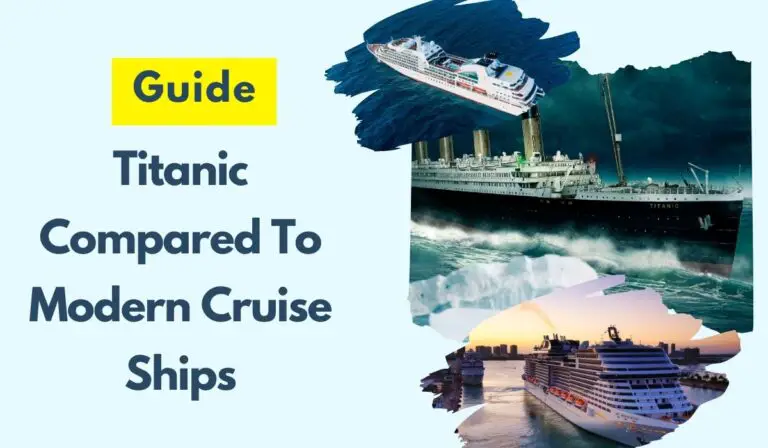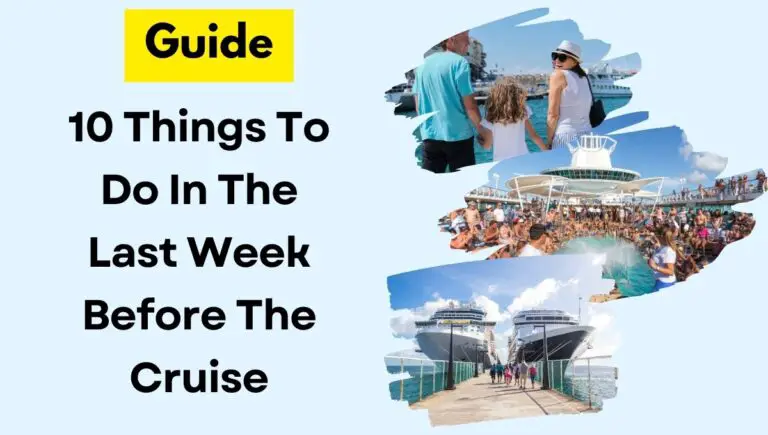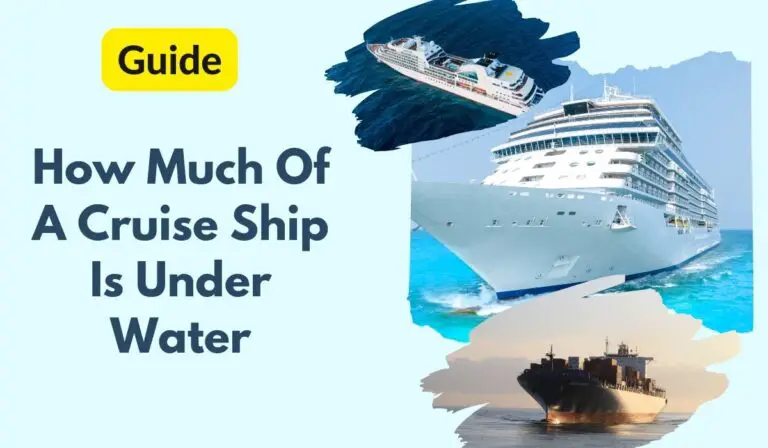How Far Can A Cruise Ship Travel In A Day?
Fear of accidents, emergencies, and bad weather is normal when cruising, especially for new cruisers.
I still remember my first cruise; I turned to my mom and asked, ‘Oh, Mom, is this thing going to zoom like a rocket, and are we at risk of sinking like the Titanic?’
After reaching a maturity level, I got my answer: No. Cruise ships travel mostly at an average speed to comfort the guests.
But do you want to know how far a cruise ship can travel in a day? If yes, you’re in the right place, mate.
Most cruise ships sail around 20 to 25 miles per hour, cruising at 18 to 22 knots. On average, they can cover anywhere from 400 to 600 nautical miles daily.
You must be confused about the nautical miles and knots, but don’t worry. My guide will explain everything in a very simple way. So the next time you cruise, you will have peace of mind and a wealth of information.
So let’s get started.
Things You Must Know Before Reading Ahead: Knots And Nautical Miles

The term Nautical miles is used for a ship’s distance measurement, and you might not be familiar with this. Don’t worry, I’ve got your back.
Remember that both Nautical Miles and Knots are different terms. Nautical miles is a standard unit of measurement while at sea. Meanwhile, the “Knots” is a unit used to measure the ship’s speed.
One nautical mile equals 1.15 land miles or 1.85 kilometers. While the One knot equals “One nautical mile per hour.”
Now, the second thing you should remember for calculating the real distance covered by the cruise ship is a formula of 1.15 miles for every knot. Easy peasy?
If you’re still confused, don’t worry. In the next sections of this guide, I’ve shared real examples of my last cruise. So keep reading to clear your mind.
How To Calculate the Average Sailing Distance Of Day
Before giving an actual answer, it’s important to know that the distance covered by the vessel depends on several factors, including weather, speed, maritime routes, and the size of the ship.
But generally, as most cruise ships sail at 20 to 25 miles per hour ( 18 to 22 knots per hour) so, at this speed, they can cover anywhere from 400 to 600 nautical miles daily, which is roughly (740-1111 km).
Although that’s not a high speed over a full day, a cruise ship can cover a significant distance.
In the next section, I’ll discuss how you can measure the distance of your voyage covered in a day.

How do you measure the distance covered by a vessel in a day?
To calculate the distance covered by a vessel in a day, we need to use the formula I mentioned in the above section.
“1.15 miles for every knot”.
Now, let’s talk about my last cruise aboard the Royal Caribbean vessel, Wonder of the Seas, with an average speed of 22 knots.
So, we can calculate the distance it will cover in a day using this formula:
Distance=Speed (in knots)×1.15 miles per knot
Distance=22 knots×1.15 miles per knot
Distance=25.3 miles per hour (40.7 km)
That represents the distance the ship Wonder of the Seas covers in an hour. To find the total distance for the whole day, we multiply this hourly distance by 24, as there are 24 hours a day.
Distance in a day=25.3 miles per hour×24 hours
Distance in a day=607.2 miles (977 km)
Hopefully, now you should be clear about how to measure the daily covered ground by the vessel.
So next time you sail, surprise your friends and family by telling them the daily distance your ship covers. Just make sure you’re aware of the speed of your vessel.
Factors affecting the cruise ship speed
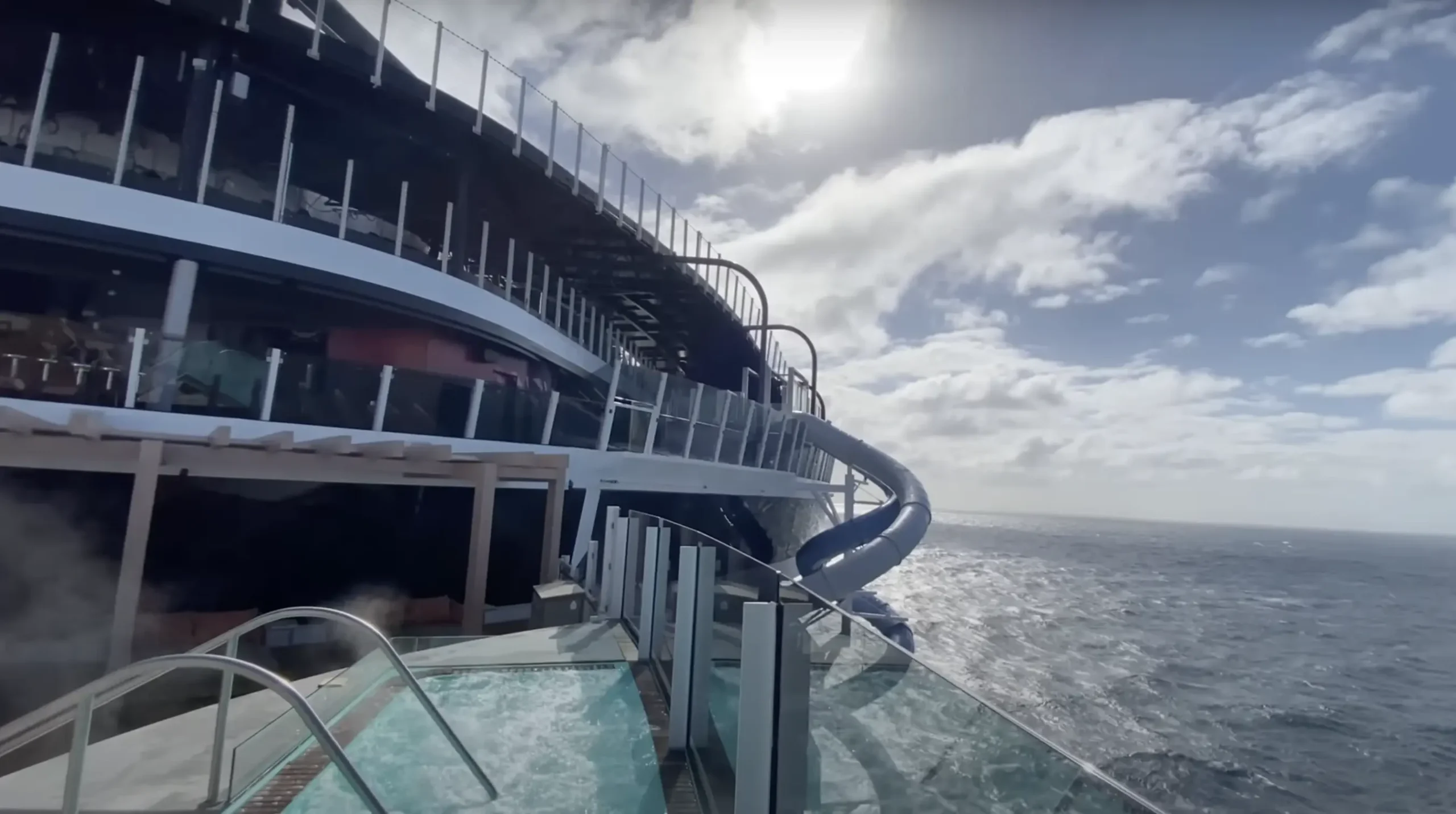
As I already mentioned, the cruise ship’s speed is affected by various factors that automatically affect the distance the vessel covers.
It’s similar to a guy jogging in extreme winds. The wind will cause more energy to be consumed and result in low speed and less distance covered.
The same happens with the cruise ship. And as you know, the oceans have extreme winds which resist the vessel and affect its speed.
But wait, that’s not only the wind affecting the vessel’s speed. Water conditions and engine performance contribute to fluctuations in its velocity.
1- Water Conditions
Water conditions are the major influencers of the cruise ship’s speed because of the currents, tides, and wave patterns.
Remember, if a ship is facing strong opposing currents or rough seas, more adjustments will be required in the ship’s speed for the safety and comfort of the guests.
Read more about cruise ship stability.
2- Engine Performance
Engine performance also directly affects the ship’s ability to propel through water.
Well-maintained and high-performance engines contribute to a smoother and faster voyage, while issues in engine operation may result in reduced speed.
3- Advanced Technologies
It’s not obvious that the speed relies on the engine performance. Many more factors affect the ship’s speed.
The difference in the speed is due to efficiency. Modern cruise ships have more advanced technology, like air bubble systems under the hull.
These bubbles reduce friction between the ship and the water, creating a smoother transition with the same fuel.
How Fast A Cruise Ship Can Travel

Generally, the maximum speed for most cruise ships is between 25-30 knots per nautical mile, which is a maximum of 35 miles per land-based mile.
Currently, Cunard’s Queen Mary 2, a transatlantic vessel, has the fastest speed for a modern-day passenger ocean liner, with 30 knots as her maximum speed.
But most vessels don’t sail at this speed as it’s not safe and economical.
As the Royal Caribbean’s Harmony of the Seas reached a maximum speed of 25 knots during her sea trials, the cruise line’s CEO clarified they would probably never have the ship sail at that speed.
Most cruise ships adopt the average speed of 20 knots per nautical mile (23 miles per hour on land) to provide extreme comfort, stability, and safety to the cruisers.
When Cruise Ships Use Maximum Speed?
Besides the safety and comfort, Cruise ships still use their max speed under specific conditions, which may include:
1- Emergency Situations
Who else doesn’t want to utilize their vehicle’s max speed to save a life in an emergency? The same thing goes with the cruise ships.
In an emergency, such as avoiding a potential hazard or responding to a critical situation, a vessel may utilize its maximum speed to enhance safety and maneuverability.
2- Meeting Tight Schedules
Cruise ships are bound of the cruise itineraries, which involve visiting multiple ports within a set timeframe.
Cruise ships might increase their speed from average to maximum to comply with these timeframes and ensure passengers have enough time to enjoy each destination.
3- Optimal Weather Conditions
During optimal weather conditions, cruise ships are likely to increase their speed.
This mostly happens when the seas are calm and the winds are mild, so sailing with the maximum speed doesn’t affect the stability and comfort of the guests.
4- Crossing Long Distances
Last but not least, cruise ships might utilize their maximum speed to cover long distances efficiently and reduce the overall duration of the journey.
When cruising across open water, especially during transoceanic voyages, vessels sail at a maximum speed.
Why Vessels Travel Mostly At Average Speed?
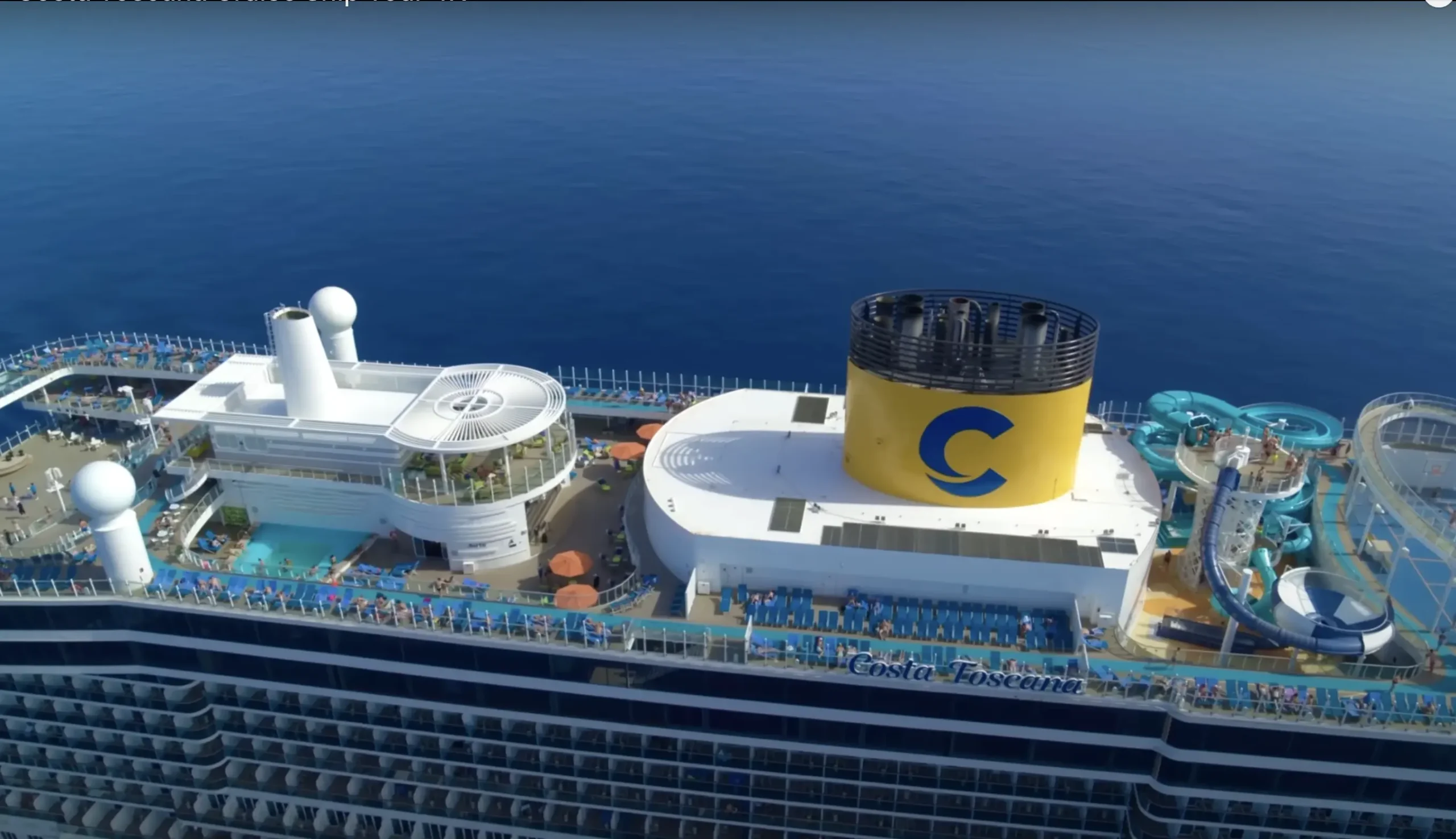
Besides having a great maximum speed, it’s important to note that cruise ships often sail at an average cruising speed.
This speed control optimizes fuel efficiency and provides stability and a comfortable experience for passengers.
Imagine sailing in rough seas. It’s a no-brainer to sail at a maximum speed that may lead to higher instability and can put thousands of lives at risk.
Although the average speed of 20 knots per nautical mile (23 miles per hour on land) is enough in specific situations, they might increase their speed.
The use of max speed is usually reserved for specific situations, as cruise lines prioritize safety and fuel conservation.
Average Cruising Speed Of Some Vessels
Below, I’ve listed some of the most popular vessels and their average speed.
- Ocean Princess: 18 knots (33 km/h)
- Carnival Legend: 22 knots (41 km/h)
- Radiance of the Seas: 22 knots (41 km/h)
- Icon of the Seas: 22 knots (41 km/h)
- Harmony of the Seas: 23 Knots (42.6 km/h)
- Quantum of the Seas: 22 knots (41 km/h)
- Rhapsody of the Seas: 22 knots (41 km/h)
- Pacific Jewel: 22.5 knots (41.7 km/h)
- Explorer of the Seas: 23.7 knots (43.9 km/h)
- Legend of the Seas: 27 knots (50 km/h)
- Queen Victoria: 23.7 knots (43.8 km/h)
- Queen Elizabeth: 23.7 knots (43.8 km/h)
- Queen Mary 2: 30 knots (55.6 km/h)
From the above list, you must be clear that the average speed of most of the ships is between 20 and 24 knots per nautical mile.
While Queen Mary 2 is an exception, with 30 knots, making it a rocket in comparison.
How Much Fuel Does a Cruise Ship Use In A Day?
It’s a commonly asked question, especially from new cruisers: how are the fuel needs of such a massive vessel fulfilled?
Their thought is valid because managing a vessel that carries anywhere from 100 to 6000 passengers is not a joke. So, it’s obvious that it consumes a high amount of fuel.
According to the College of Engineering and Applied Science at the University of Colorado Boulder, a large ship might consume up to 250 tons of fuel daily. (80,000 gallons of duel a day).
Regular-sized ships, by contrast, may use up to 150 tons of fuel per day.
As vessels shrink in size, their fuel consumption also decreases.
The Influence of Ship Size on Daily Travel Distance
It was mentioned that the ship size directly affects the distance the cruise ship covers in a day.
Unsurprisingly, the bigger the cruise ship, the lower its average speed will be.
Since larger vessels are equipped with more powerful (heavier) engines and larger fuel tanks, the ship will have more mass to move through the water, directly affecting the speed.
Imagine yourself running with a heavy-loaded bag. It will result in a lower speed.
As a result of lower speed, a ship will cover less daily distance.
But on the positive side, larger ships prioritize stability and comfort over speed, as passengers generally prefer a smoother journey instead of risking their lives.
So that’s why cruise lines often opt for a balance between size, speed, and passenger experience, leading to lower average speeds for larger vessels. However, maximum speed is reserved for emergencies or specific deadlines.
Cruise Ship Speed Regulations: Safety Measures and Guidelines
Various vessel speed regulations ensure the well-being and security of passengers, crew, and the vessel.
Here are the main objectives of cruise ship speed regulations:
1- Safety At Sea:
Sailing at a normal speed ensures guests a safe, stable, and comfortable cruising experience.
Plus, it helps prevent accidents, collisions, and other navigational hazards in areas with heavy maritime traffic.
So what’s better than having the peace of mind that your cruise ship is safe?
2- Environmental Protection
Maintaining a controlled and safe speed for cruise ships is important for minimizing environmental impact and pollution.
The marine ecosystem will stay safe with the reduced risk of accidents that could result in oil spills.
Plus, the maximum speed of a vessel causes more fuel to burn, resulting in high air pollution. So that’s why cruise ships adhere to speed safety regulations.
3- Port Safety
Sticking to the speed regulations ensures safe navigation in and around ports, where vessels often face restricted and congested waters.
4- Passenger Comfort
The aforementioned high speed results in discomfort and instability for the cruise ship, which might lead to a worse cruise experience for guests.
So that’s why moderate speeds contribute to a smoother and more comfortable journey for passengers.
FAQs
Why Do We Use Knots Instead of Miles Per Hour?
In Maritime navigation, Knots are commonly used instead of Miles per hour because they align with nautical distance on charts and are a standard unit of sailors globally.
How Cruise Ship Speed Differs Between Ocean Crossings and Coastal Cruises
The cruise ship speed varies between ocean crossings and coastal cruises due to various factors, including distance, navigational requirements, and passenger experience preferences.
How far can a cruise ship travel in a day?
A cruise ship travels from 400 to 600 nautical miles daily. (700-1111 km)
Final Words
Hopefully, now you should be clear about how much a cruise ship travels in a day and its average and maximum speeds.
Just remember that cruise ships mostly sail at an average speed to ensure passengers’ safety and adhere to speed regulations.
Next time you go on a cruise vacation, surprise your family and friends by letting them know the daily distance of your voyage.
Have a safe and enjoyable cruise experience.
I am Zoe Grace, a passionate enthusiast of cruise ships. With a decade of firsthand experience in the cruising industry, I have developed a deep understanding of the intricacies and wonders that these majestic vessels hold.
Now, I am excited to embark on a new journey as an author, sharing my knowledge and insights with readers who share my fascination for the world of cruising.
Join me as we explore the captivating world of cruise ships together.


